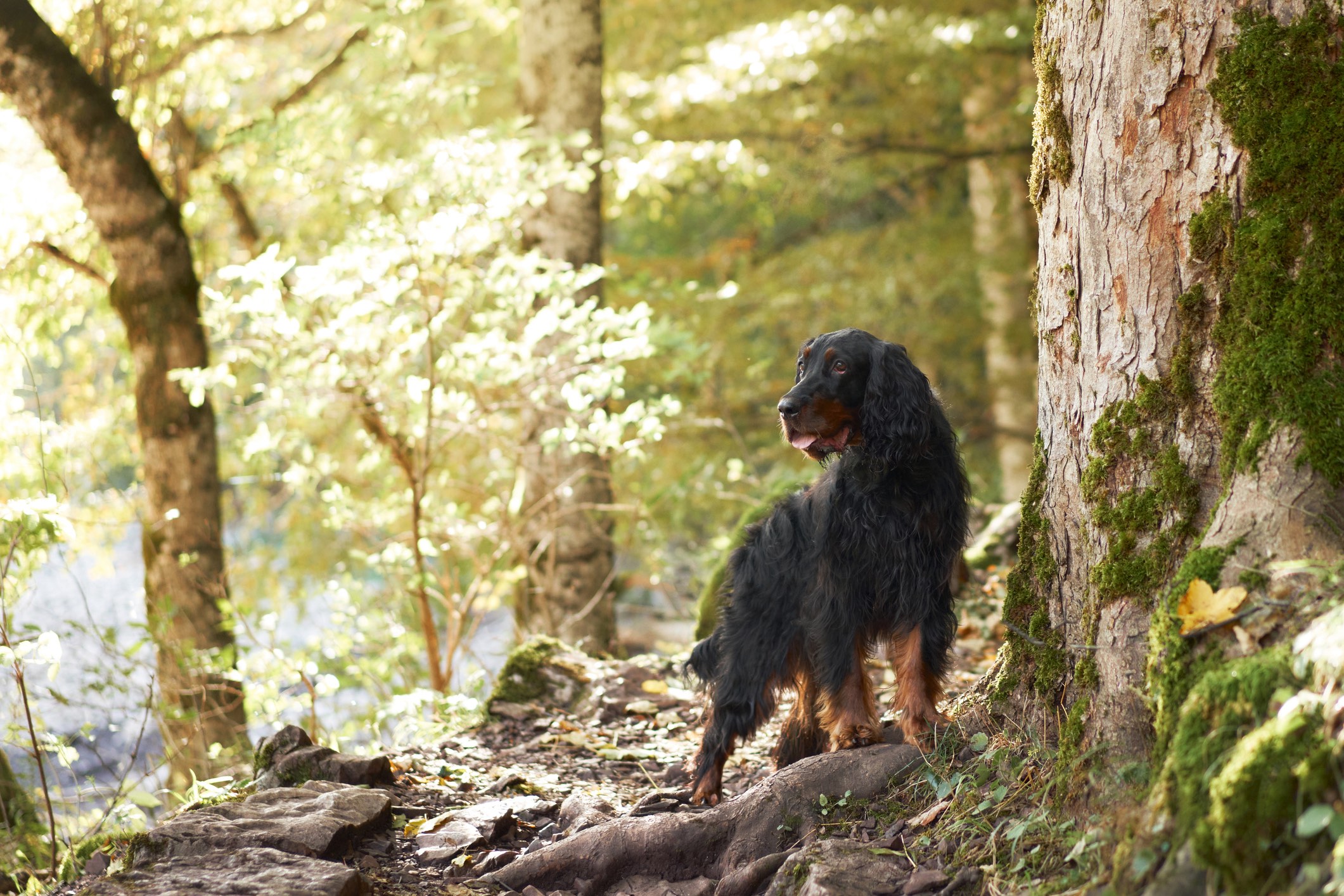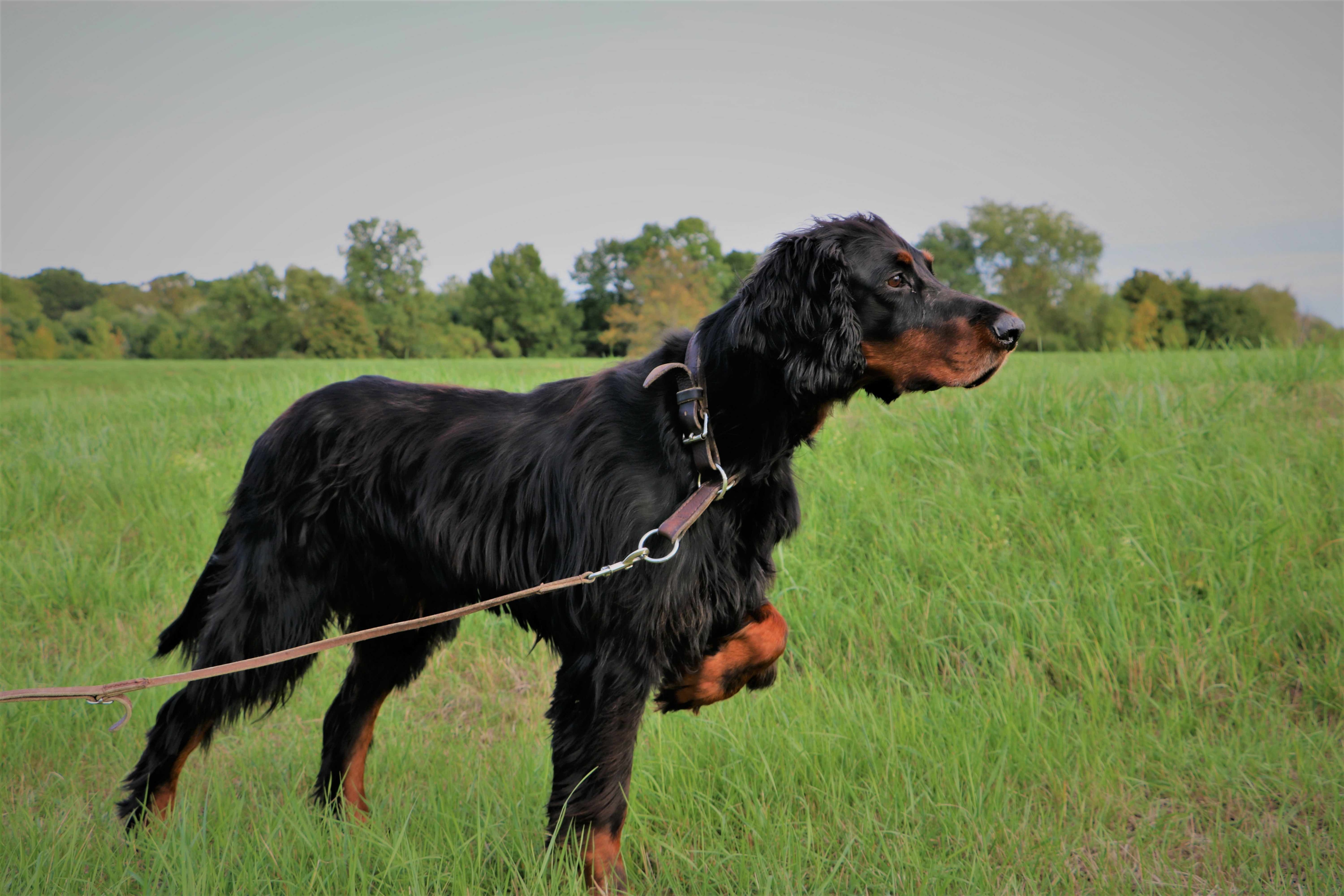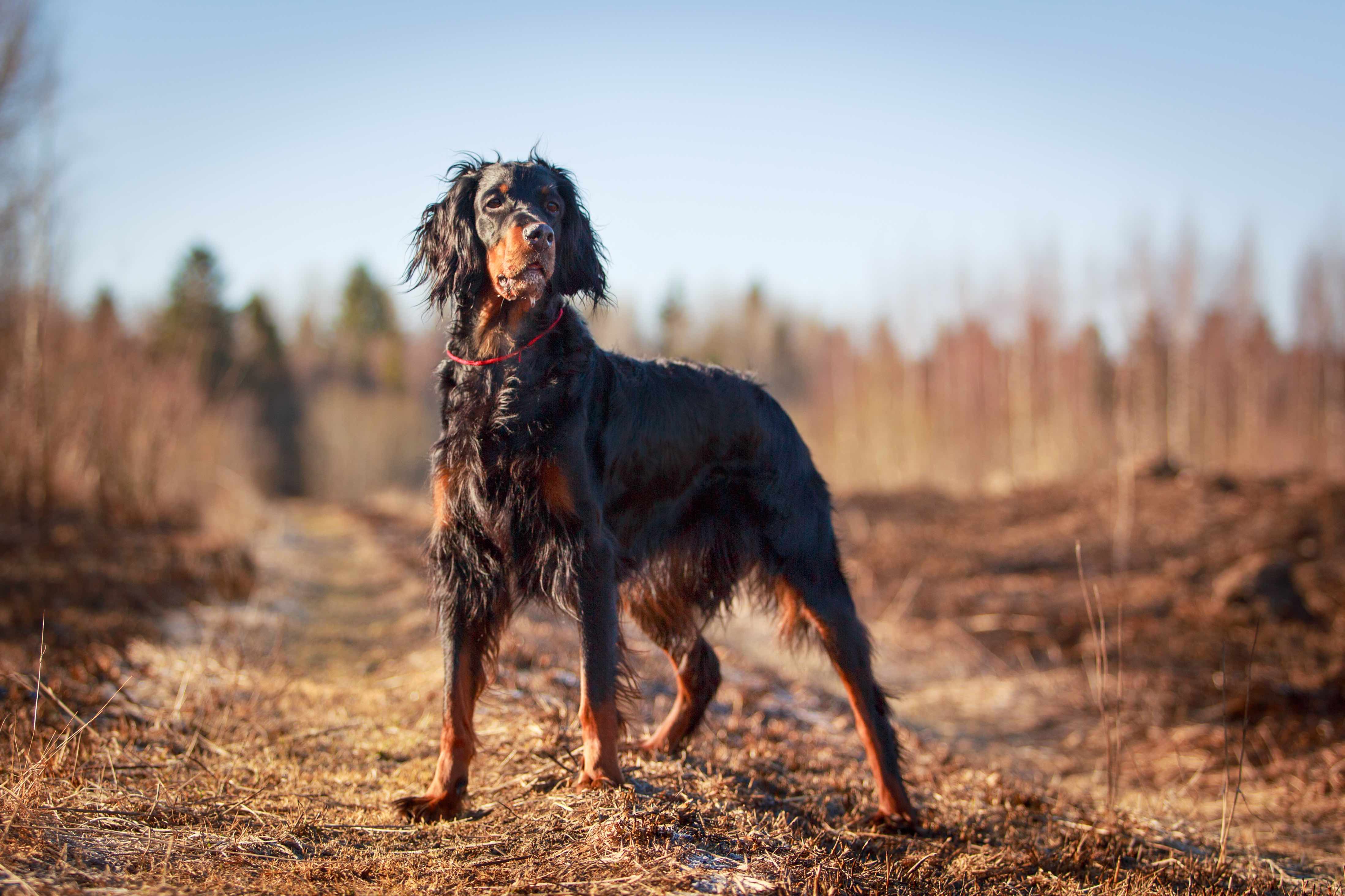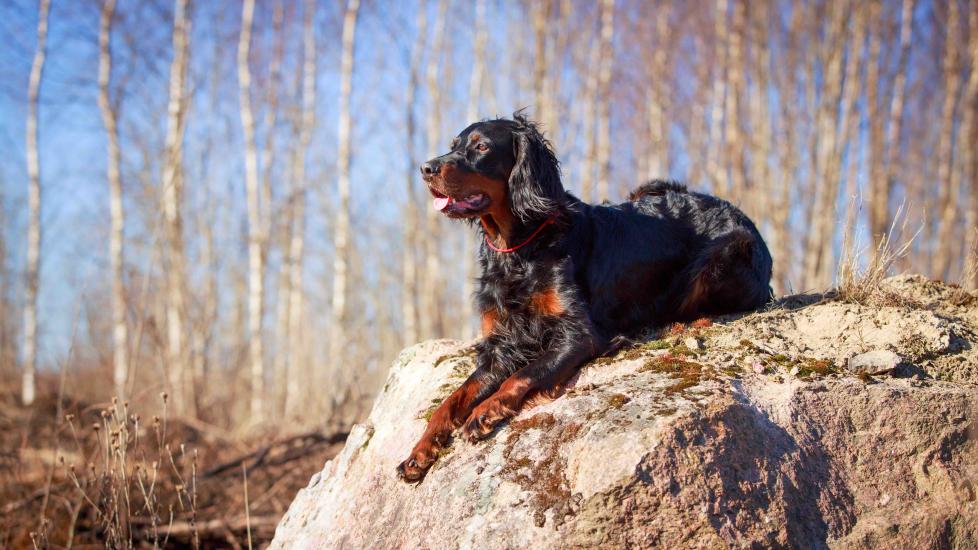Gordon Setter
Adobe Stock/DragoNika
Gordon Setters trace their roots to 1820s Scotland, where they were bred to hunt birds such as pheasants and quails. The dogs get their name from Duke Alexander Gordon, who established the breed.
Today, Gordon Setters are still used as hunting dogs, but they also serve as devoted and lively companion pets. They have a black and tan coat, stand 23–27 inches tall, and weigh between 45–80 pounds.
Caring for a Gordon Setter
The Gordon Setter breed is alert and loyal toward their family, but they may be wary around strangers at first. Though bred to be a hunter, they can thrive in any outdoorsy family and enjoy activities like hiking. Gordons need at least an hour of exercise every day.
That said, it’s important to remember that your Gordon Setter can have strong hunting instincts and may follow their nose into trouble, according to the Gordon Setter Club of America (GSCA). Their prey drive might lead them to chase neighborhood birds, so always keep your Gordon Setter dog on a leash or inside a securely fenced area.
When they’re not romping around outside, the breed loves staying close to their family at home.
Gordon Setter Health Issues

The Gordon Setter is a generally healthy dog breed with an average lifespan of 12–13 years. However, like many breeds, they are prone to a few genetic problems that could be costly. Pet parents may want to invest in pet insurance when bringing home a Gordon Setter puppy.
Gastric Dilatation-Volvulus (GDV)
Gastric dilatation-volvulus is a severe form of bloat in dogs that affects deep-chested breeds, including the Gordon Setter. This is a life-threatening condition in which the stomach fills with gas and twists, cutting off blood flow. Warning signs include:
-
Vomiting without producing anything (retching)
-
Swollen and distended abdomen
-
Excessive drooling
-
Inability to settle
-
Pacing, restlessness
-
Lack of appetite
Families with Gordon Setters need to be aware of the signs of GDV and take their dog to an emergency veterinarian immediately if they observe any of these symptoms. GDV may be avoided with a gastropexy procedure.
Hip Dysplasia
Hip dysplasia is a condition where the hip joints become loose, which can cause pain and eventually lead to arthritis. Warning signs include an inability to get in and out of cars, limping, and lameness.
Treatment varies depending on the hip dysplasia’s severity but can include weight management, joint supplements, or surgery.
Progressive Retinal Atrophy (PRA)
Progressive retinal atrophy is a genetic condition where the rods and cones of the eye break down, leading to blindness. There is no treatment, but blind dogs can live long and happy lives with the proper care. Reputable Gordon Setter breeders will test their dogs for this condition.
Hypothyroidism
Hypothyroidism happens when a dog’s body doesn’t produce enough thyroid hormone. Signs of hypothyroidism include:
-
Weight gain despite no changes in diet or exercise
-
Poor coat condition (dry, brittle fur)
-
Heat-seeking behavior
-
Increased skin infections and ear infections
Talk to your vet if you notice any of these symptoms in your Gordon Setter. Dogs with hypothyroidism can live long, happy lives with lifelong medical treatment.
What To Feed a Gordon Setter

To choose the best dog food for a Gordon Setter, consider your pup’s health, age, and lifestyle. Younger and more active Gordon Setters have different needs than their senior counterparts.
Talk to your veterinarian about the best food for your dog. Selecting a food approved by the Association of American Feed Control Officials (AAFCO) is a good place to start. Gordon Setter puppies need to eat a puppy-specific food before transitioning to an adult diet.
How To Feed a Gordon Setter
Because Gordon Setters are prone to bloat, pet parents should take some precautions when feeding their dog:
-
Restrict exercise an hour before and after mealtimes
-
Avoid using raised food bowls
-
Feed multiple smaller meals throughout the day instead of one big meal
How Much Should You Feed a Gordon Setter?
There is no across-the-board recommendation on how much to feed your dog. Instead, work with your veterinarian to determine portions that consider your dog’s age, health, and lifestyle.
Your AAFCO-compliant dog food will also provide guidance on feeding, based on your dog’s weight. This is a good recommendation to begin with until you can talk to your vet.
Nutritional Tips for Gordon Setters
A dog receives all necessary nutrition through their AAFCO-compliant dog food. However, sometimes your vet will recommend supplements depending on your pup’s health. Gordon Setter dogs may benefit from joint supplements, probiotics, or omega-3 fatty acids (fish oil).
Never give your dog a supplement without speaking to your veterinarian first.
Behavior and Training Tips for Gordon Setters
Gordon Setter Personality and Temperament

Gordon Setters are full of energy; they need regular exercise and mental stimulation to keep them happy. These friendly dogs can be great with children, according to the breed club, especially when they’re introduced to children during puppyhood. Remember that every interaction between kids and dogs should be supervised, and children must be taught how to appropriately interact with dogs.
Gordon Setter Behavior
Though they have lots of energy outside, Gordon Setters are known to be calm dogs at home. While they will bark to alert their family or to get attention (the breed club calls them “great talkers”), this breed isn’t known to be overly vocal. However, Gordon Setters may bark excessively—and become destructive—if they’re allowed to grow bored.
Gordon Setter Training
All dogs, including the Gordon Setter breed, need obedience training as puppies. Use positive reinforcement methods like praise and treats to teach them basics like “sit” and “come.” Recall training is especially important for Gordon Setters due to their high prey drive.
Gordon Setter puppies need socialization to grow into confident adults. Expose your puppy to new people, animals, environments, and sounds early and consistently so they become comfortable in new situations.
Fun Activities for Gordon Setters
-
Hide and seek
-
Obedience
-
Hiking
Gordon Setter Grooming Guide

Because of their long, feathered, black-and-tan coat, Gordon Setters require weekly grooming to stay free of tangles.
Skin Care
Some Gordon Setters develop itchy skin due to seasonal allergies. Talk to your veterinarian if you notice changes in your dog’s skin (such as redness or flaking) or if they seem excessively itchy. Your vet can help devise a treatment plan.
Coat Care
Expect to brush your Gordon Setter every week to keep tangles at bay, as this breed is prone to matting and needs an attentive at-home grooming routine. Pay special care to the fur between the toes, which needs to be properly trimmed, according to the GSCA.
Eye Care
A Gordon Setter dog’s eyes must be checked by a veterinarian during their annual wellness exams for signs of PRA or cataracts.
Ear Care
Gordon Setters have long, floppy ears that hang on either side of their face. Because of this, moisture and debris can easily become trapped in the ear canal and cause infections.
Clean your Gordon Setter’s ears regularly; ask your vet how often to do this. You must also clean their ears every time your dog has been in water, such as after swimming or a bath. Always use a veterinarian-recommended ear cleaner for dogs.
Considerations for Pet Parents
The perfect home for a Gordon Setter is with an active and outdoorsy family. The breed needs robust exercise to expend their vast energy stores. This is also a very smart dog, and pet parents should be ready to exercise their dog’s mind as well as their body.
Positive training and consistent socialization are important to start on day one with this breed. Along with exercise and training, pet parents need to dedicate time to brushing their Gordon Setter at least once a week.
Gordon Setter FAQs
Is a Gordon Setter a good pet?
Gordon Setters can make excellent pets because of their friendly demeanor, loyalty, and gentleness around children.
Do Gordon Setters bark a lot?
Gordon Setters do bark, but they don’t have a reputation for barking excessively for no reason.
Is a Gordon Setter rare?
Yes, Gordon Setters are rare, and it can be difficult to find a puppy. However, the breed has grown in popularity in recent years and ranks as the AKC’s 99th most popular dog breed.
How big do Gordon Setters get?
Gordon Setters typically stand 23–27 inches tall and weigh 45–80 pounds. Females are usually smaller than males.
How much does a Gordon Setter cost?
The Gordon Setter price is anywhere from $1,000 to $2,000 depending on breeder, bloodline, and location.
What’s the difference between a Gordon Setter and an Irish Setter?
Gordon Setters share similarities to Irish Setters, but they are separate breeds with distinct differences. Irish Setters have a deep red coat, while Gordon Setters have black and tan fur. Irish Setters were developed in Ireland, while Gordon Setters hail from Scotland.
